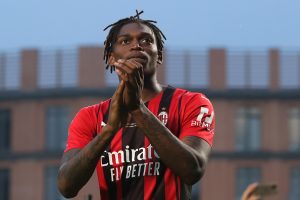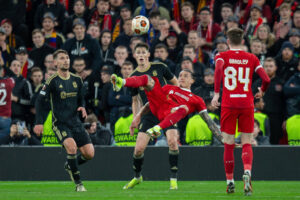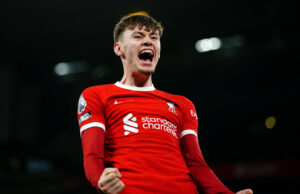Given football’s unchallenged position as the world’s favourite game, perhaps it is surprising that there have not been more major on-field protests by footballers and football teams in the history of the sport. Certainly, there are few, if any, footballing protests that are as iconic as the Black Power salute by Tommie Smith and John Carlos at the Mexico Olympics in 1968, or Muhammad Ali’s refusal to be drafted for the Vietnam War a year earlier, which effectively led to his ban from boxing for several years and meant that the greatest boxer ever was probably robbed of the prime part of his career.
However, perhaps it is precisely because football is so popular and therefore has always attracted the interest (often the controlling interest) of tycoons, media moguls and even tyrants, that it has been robbed of much of its potential for activism. Put simply, perhaps there has always been so much at stake with football, the most popular of sports, that other less popular sports have led the way in terms of awareness-raising.
That may be changing now, in what appears to be a new era of athlete-activism, as shown by the twin protests by the Norwegian and German men’s football teams this week. They used the start of qualifying for the 2022 World Cup to draw attention to the appalling human rights record of Qatar, the host of the next World Cup, particularly when it comes to deaths among the migrant workers who are building the stadia that will host the tournament in just over 18 months’ time – more than 6,500 in total, according to a report by The Guardian last month.
And even in the past, there have been footballers – both male and female – who have been prepared to risk criticism, financial loss or worse to make a protest. Here, in un-chronological order (i.e. starting with the most recent) are five of the most famous.
Famous Football Protests
5. Taking the Knee (2020 and Onwards)
The Norwegian and German men’s international teams may well have been emboldened to take their public stance against their potential host next year by the widespread success, or at least widespread adoption, of the gesture of taking the knee to protest against racism by footballers around the world over the last year. Of course, the ‘footballer’ who initially took the knee was not a soccer player at all but an American footballer, or NFL player, Colin Kaepernick, the San Francisco 49ers quarterback, who first took the knee in August 2016 in protest at police brutality towards young black men in America, which included numerous police killings. However, it was the murder of one black man in particular, George Floyd, in Minneapolis nearly four years later, probably because it was caught on camera in all its hideous detail, that led to the almost universal adoption of the gesture by sports teams, including football teams, around the world.
As we approach the first anniversary of George Floyd’s death, the near unanimity among sportspeople and particularly footballers of all colours in taking the knee has begun to fracture. In the Premier League, for instance, Wilfried Zaha has publicly stated that he will no longer take the knee, in protest at what he regards as the inability to translate widespread support for the gesture into meaningful action against racism, in particular the racist abuse of black footballers such as Zaha himself on social media. Nevertheless, there is no doubt that taking the knee has been the most high-profile and widely supported on-field protest in the history of all sport, let alone football. And the hope remains that social media companies, for one, will finally take the action that is required of them.
4. Megan Rapinoe Takes the Knee (2016)
Megan Rapinoe is the best player and the public face of one of the greatest international football teams ever, the current USA Women’s Team, which is one of only four international men’s or women’s football teams to have won two successive World Cup tournaments. And if, as is entirely possible, the USA make it a hat-trick in Australia and New Zealand in 2023, they will deserve to be regarded as the greatest ever international football team of either gender.
However, Rapinoe has never been satisfied with just being a supremely successful player; she has also often been the world’s most outspoken footballer of either gender. As an openly gay woman, she has long been a public campaigner for greater LGBT+ awareness and equality. And only this week, while her male Norwegian and German counterparts were making their protest about Qatar 2022, she appeared at an event at the White House in America to publicise Equal Pay Day in America, an event designed to heighten awareness of the continuing pay gap between men and women in all economic and cultural sectors, saying: “I’ve been devalued, disrespected, dismissed because I am a woman”.
However, arguably her finest moments of activism came in 2016 when she became the first footballer of either gender to follow the lead of Colin Kaepernick and take the knee, first in a domestic match in America and then in an international match for the USA against Thailand. She said at the time, in expressing her support for Kaepernick and those he sought to represent, “Being a gay American, I know what it means to look at the flag and not have it protect all of your liberties”. And just in case anyone thought that she would cool her ardour in her advancing years, she declared ahead of the World Cup in France in 2019, in which she was instrumental as the USA retained the trophy they had won in Canada four years earlier, that if the USA won she would certainly not accept an invitation to visit the White House to meet Donald Trump. In fact, she inserted the most well-known expletive in the world before the words “White House” just to make sure her message was received and understood.
3. James McClean’s Poppy Protests (2012 and Onwards)
James McClean is probably more famous for refusing to wear a poppy on his shirt, a stand that he first took on Remembrance Day in 2012 in a Premier League match for Sunderland against Everton, than he is for his footballing achievements, which, having been a Premier League and Championship player as well as a Republic of Ireland international for nearly a decade, are considerable. However, that is probably a testament to the controversy he has generated in Britain, both inside and outside football, for taking his stand, which he has always claimed is a matter of personal principle.
McClean hails from the Catholic side of Northern Ireland and so has always claimed that for him the poppy has not been so much a symbol of remembrance for those who lost their lives in the two World Wars and subsequent conflicts as a reminder of what he regards as the continuing British occupation of the part of the island of Ireland that he was born in. He has attracted support for his stance from fellow players, such as David Meyler (another Ireland international), and even from the former Republic of Ireland manager Giovanni Trappatoni. However, he has also attracted enormous opprobrium, not only from opposing fans during Premier League and Championship matches but even from Irish sportswriters. Some of whom have claimed that his refusal to wear the poppy is an insult to the many thousands of men from Northern Ireland, from both the Protestant and Catholic traditions, who gave their lives in the two World Wars, to defeat first German imperialism and then Nazism. Suffice to say that McClean’s ongoing one-man protest is probably the most controversial in football history.
2. Robbie Fowler’s ‘Dockers’ T-Shirt (1997)
Liverpool’s fans have long been regarded as being not only among the most passionate in all of football but among the most fair-minded, loudly applauding even opposition players if they felt that they had earned it. Famously, they stayed behind to applaud the Arsenal team that broke their hearts in 1989 by scoring the last-second winner that won the league title; seven years later, they applauded one particular Arsenal player, David Seaman, at the start of a match in recognition of his impressive performances at Euro 96; and if the pandemic hadn’t prevented it, there had been much talk among Liverpool fan groups of similarly honouring Marcus Rashford, even though he played for their most loathed rivals Manchester United, in recognition of his incredible fundraising and awareness-raising efforts regarding child poverty. However, even if Liverpool fans have occasionally applauded opposition players, their greatest admiration has naturally been reserved for their own players, and perhaps above all Robbie Fowler.
In the entire history of Liverpool Football Club, Fowler’s on-field achievements do not match those of the greatest Liverpool legends, from Billy Liddell (the Scot who was so central to the team that they were nicknamed ‘Liddellpool’) to Kenny Dalglish to Mo Salah. However, being a local lad and a particularly cheeky one at that (a typical Scally, as the Liverpudlian term has it), Fowler always enjoyed a particular affinity with Liverpool fans, to the extent that he was even nicknamed ‘God’, which in nickname terms at least put him ahead of ‘King Kenny’. But there was one particular incident that really cemented the Kop’s enduring affection for Fowler, which was the moment in an otherwise routine European victory over SK Brann of Norway in 1997 when he scored the first of two goals and then lifted his Liverpool shirt to reveal a T-shirt underneath that said: ‘Support the 500 Sacked doCKers’.
The ‘doCKers’ in question were Liverpool dock workers who had been fired in a dispute with the owners of the city’s docks. And the reason that the “CK” in dockers was capitalised was not only a play on the then-ubiquitous Calvin Klein brand logo but, rather incredibly, because Calvin Klein had apparently given Fowler permission to use their logo to raise awareness of the sacked workers’ plight. That must surely be the only time that one of the most potent symbols of American capitalism has ever joined together with a high-profile footballer to raise awareness of an industrial dispute in a European city.
1. Matthias Sindelar’s ‘Waltz’ During the Anschluss Match (1938)
Perhaps the most extraordinary, and costly, protest that any footballer has ever made was that of Matthias Sindelar on 3 April 1938, during the so-called ‘Anschluss Match’ between Germany and the newly annexed Austria, which was supposed to ‘celebrate the return of Austria to its supposed Fatherland of Germany. However, Sindelar had other ideas and publicly sabotaged the propaganda exercise, ultimately paying for it with his life.
Sindelar was Continental Europe’s first footballing superstar, an inside forward of such skill and scoring prowess that he was not only the star of Austria’s ‘Wunderteam’ of the 1930s, which had been the favourites to win the 1934 World Cup before they lost to hosts Italy in the semi-final, but was even rumoured to have attracted the interest of the top teams in England, including the then all-conquering Arsenal. However, such was Sindelar’s love for Austria Vienna, for whom he was a one-club man throughout his career, and for the city itself, especially its celebrated café culture, that he never seriously considered a move abroad.
However, when the Nazis annexed Austria in 1938, Sindelar’s domestic idyll was destroyed. First, Austria itself lost its independence. Then the Nazis began carrying out the purge of Jews and Jewish culture that it had already launched in Germany, which extended to removing players who were Jewish (or just thought to be Jewish) from Austria Vienna and other top teams in the country. And for the final insult, they organised what was supposed to be an exhibition match to celebrate the unification of the two top nations.
Sindelar, however, refused to play ball. After limply going along with the rest of his team for the first half, during which Austria laboured against an obviously inferior German side, he decided to act. For whatever reason – patriotism, a loathing of the Germans (the traditional rivals of Austria), or simply a refusal ever to lie down and lose a football match – he turned on the style to score one goal and set up another, as Austria eventually won 2-0. Then, to add insult to injury, he celebrated wildly in front of the gathered Nazi dignitaries, which some in the crowd claimed afterwards included an extravagant Viennese waltz.
Nazis being Nazis, Sindelar paid with his life. He was first exiled from football and then, within a year, he and his Italian girlfriend (who was rumoured to be Jewish) died in the most mysterious of circumstances. Ostensibly, they died of carbon monoxide poisoning, caused by a faulty gas heater, but in all likelihood, they were murdered by the Nazis.
Main Photo






